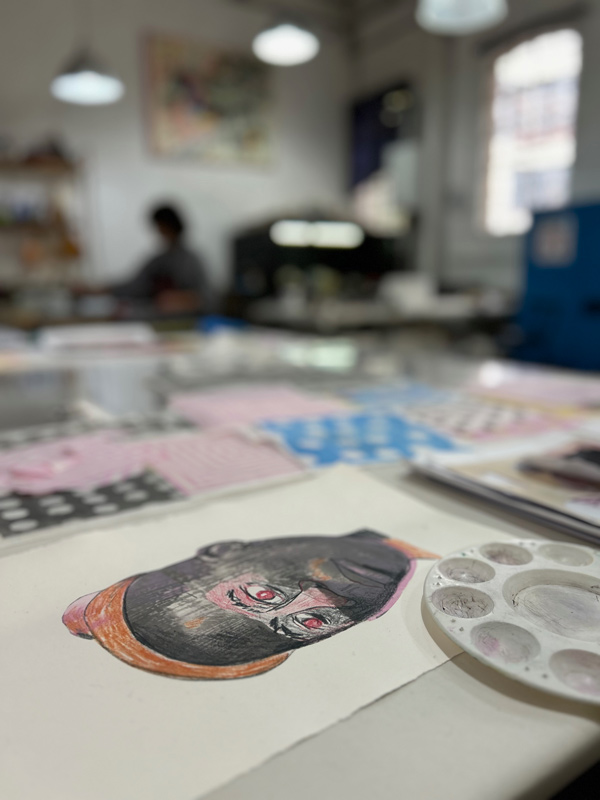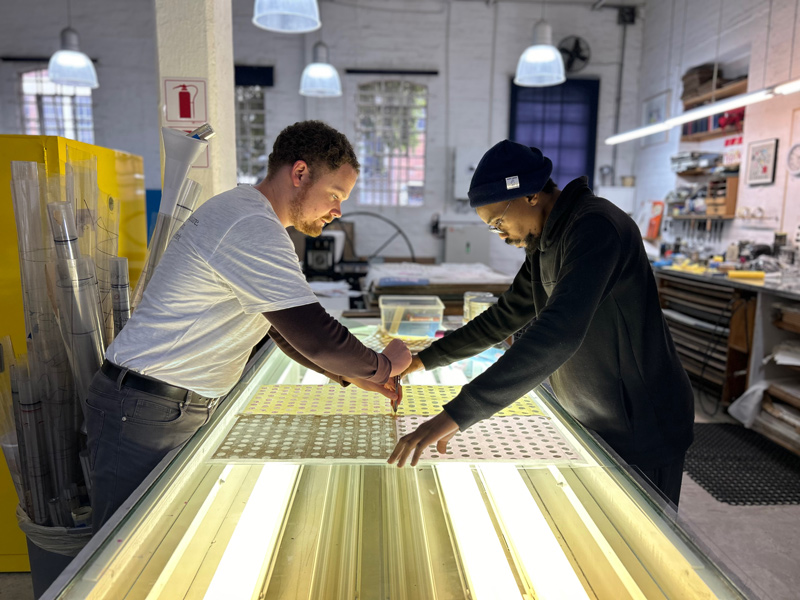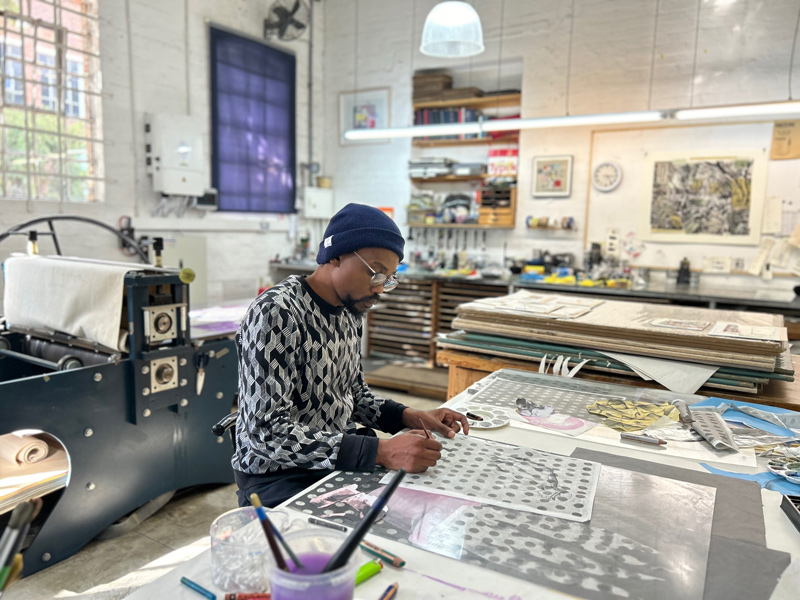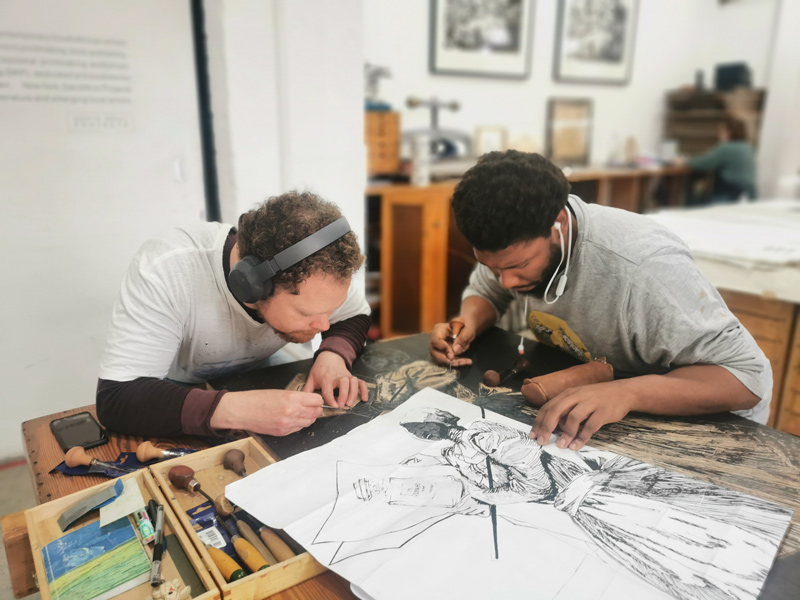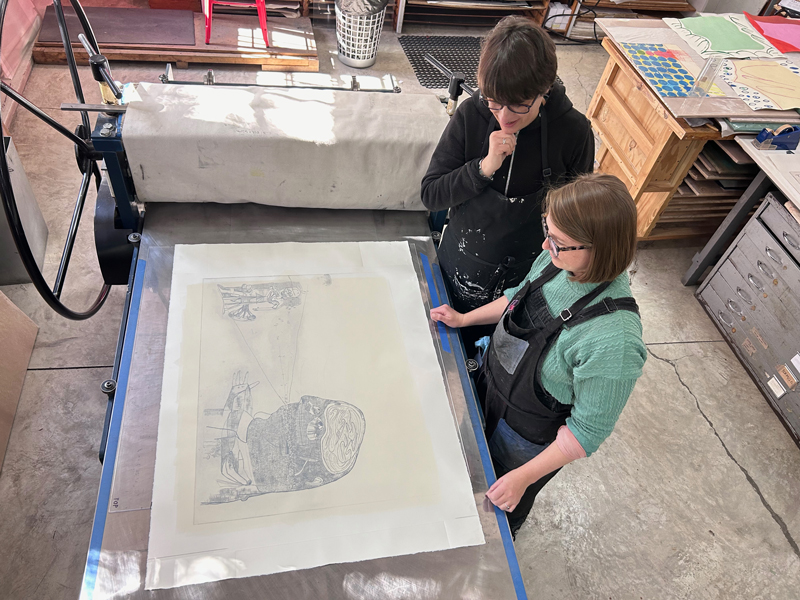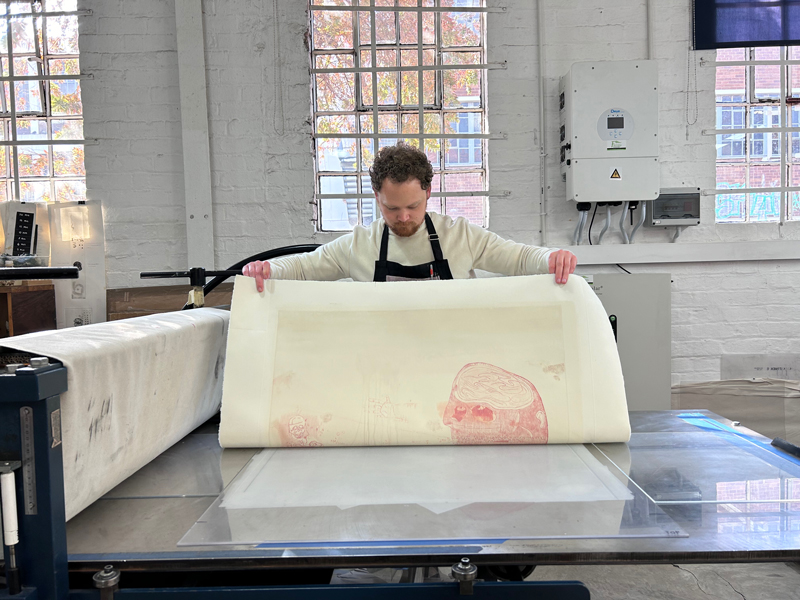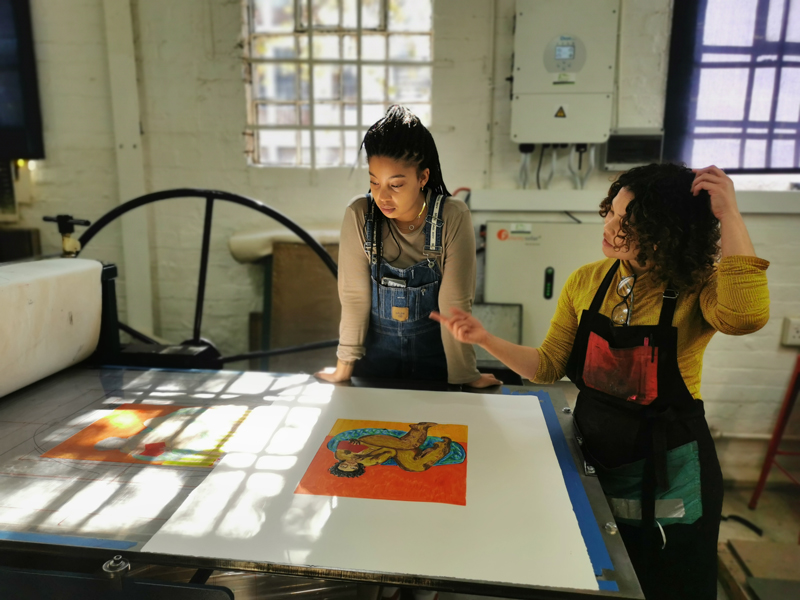For 25 years, David Krut has been collaborating with artists in Johannesburg and introducing them to an audience in New York. To celebrate this legacy, we’re excited to showcase several extraordinary South African artists who have worked in the same workshop in Johannesburg as William Kentridge.
Over the years, we’ve nurtured strong relationships with renowned artists like Kentridge, as well as Diane Victor and Deborah Bell. While we continue to work with these established names, we’re equally committed to nurturing emerging South African talent. Amé Bell, Director at David Krut Projects in Johannesburg, is dedicated to discovering new artists with fresh visions and ideas, who often need even stronger support to gain recognition beyond the African continent.
To that aim, we’re excited to introduce a number of new names in New York as part of what we hope will be an ongoing initiative: “SOUTH AFRICAN ARTISTS IN NEW YORK.” We will be showcasing several extraordinary artists and artworks this fall, with more to come to our gallery and the Brooklyn Fine Art Print Fair in Spring 2025.
A selection of works by each artist will be available to view in NYC in late September 2024. For more information or to schedule a viewing, please email [email protected]. David Krut Projects, New York is located at 526 West 26th Street, Suite 816, New York, NY 10001. Hours: Tuesday – Saturday between 11am – 6pm.
The first is multi-disciplinary artist Phumulani Ntuli, born in the South Western Townships, more commonly known as Soweto, in Johannesburg.


Ntuli was born in 1986 in White City. In his youth he enjoyed playing music and in high school his interest in the creative fields later expanded into literature and visual arts. Ntuli went on to complete a BTech degree in Visual Arts at the University of Johannesburg.
The artist then was awarded a Masters in the Fine Arts – Arts Public Sphere from Ecole Cantonale D’Art du Valais (ECAV) in Sierre, Switzerland. Achieving Prix-excellence for his ongoing research project “Permutations of an event” which centred around notions of archives and surveillance.
“…to collage is to process information, through cutting, slicing, joining, displacing, and concealing. It is a performative model of practice to counterfeit, in this gesture creating alternative forms of looking and meaning.”
Ntuli’s practice revolves around working with mixed media collages, sculpture, video installation and artistic research. Working between documentary and fiction, Ntuli’s practice deals with omissions within archives. As he explains: “The continued themes I have explored in my practice have been notions of black futurity, the archive and its tensions. I consistently delve within notions of collective autobiographies and their surrounding social political conditions.”
Ntuli was one of three selected artists to represent South Africa at La Biennale Arte in Venice in 2022 and continues to exhibit David Krut Projects in South Africa as well as various museums and art festivals internationally.
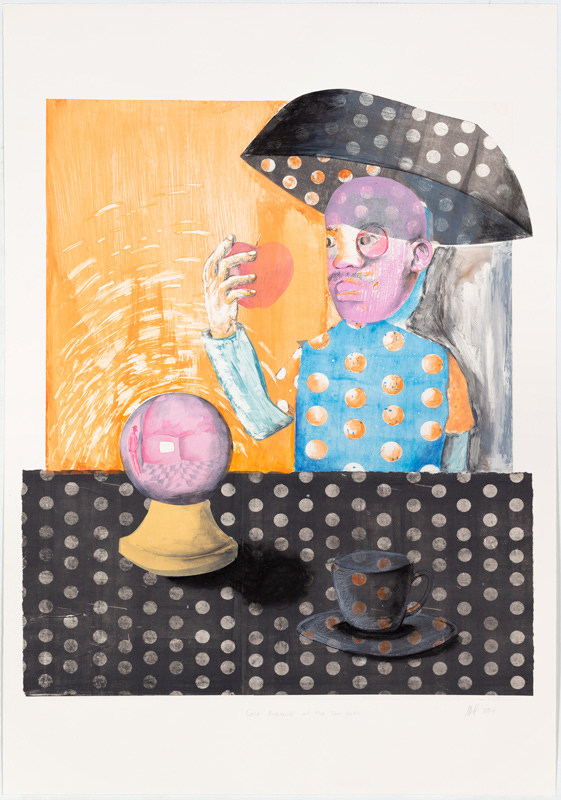
Our collaboration with Ntuli began in 2023, where the artist spent several weeks collaborating with Kim-Lee Loggenberg at the David Krut Workshop (DKW) to produce large, complex unique works combining painting and collage while using an old-fashioned printing press. He returned in 2024 to produce a second body of work, focusing the arrangement of digital material and coding or hand-cutting and painting to reframe data in the creation of a “pseudo-reality.”
Describing Ntuli’s work, Lukanyo Mbanga writes: “The brilliance of Phumulani Ntuli’s opus is that time and space are both central and yet suspended. The past finds its way in the present, and the present seems occultic enough to suggest a distant future. The ability to find temporal and spatial connection across the broad spectrum of history is essential in our complex society. South Africa is still straddling the effects of the colonial system whilst also trying to establish a new narrative.
We don’t want the struggles of the past to be our continued story and Ntuli’s works demonstrate that it doesn’t have to be. We can simply use the past to reimagine new narratives, to celebrate traditional emblems and give them a place in our contemporary reality.
In support of this notion, the incongruous patterns of different wrapping paper is jolting for just a moment until the absurd blend of colour and image begins to settle into a strange coherence. It’s like eyes trying to adjust in the dark until the obscure shapes and shadows make themselves familiar to you.
It’s difficult to pinpoint how these art works do that exactly. Is it the domestic patterns of the wrapping paper that we’re all vaguely familiar with? Is it the pastel tones of the colour palettes that are somehow both arbitrary and emblematic of a ‘home’ landscape?
Whatever it is, there is a clear sense of unifying the fragmentary that allows anyone, no matter their race, ethnicity or culture, to find a relatable aspect. It just takes a willingness to be open to new possibilities of what reality can be.
In other words, what if we could adjust our eyes to seeing traditional Africa not as ‘another world’ but rather as an ingrained aspect of our everyday society? As something that can be futuristic as well.”
The second artist we are honored to introduce is Mary Sibande, a multidisciplinary visual creator working through the mighty medium of story creation.


Mary Sibande, born in 1982 in Johannesburg, has gained worldwide recognition for her striking sculptural installations, photographs, and more recently, prints. Her practice primarily revolves around the creation of elaborate visual narratives that explore themes of identity, race, gender, and labor in post-apartheid South Africa. As an artist who draws inspiration from her country’s rich history, it was clear why she was chosen to represent South Africa at the Venice Biennale in 2011.
Sibande’s work is characterized by her use of large-scale figurative sculptures and installations, often featuring her alter-ego, Sophie. These powerful pieces have been exhibited in prestigious venues worldwide, including the Venice Biennale and the Smithsonian’s National Museum of African Art.
“We’d been brought up with the attitude that things were the way they were and we should just deal with it. If our mothers questioned things, they were thrown in jail. But suddenly we were able to question things. Part of what I’m doing is celebrating questioning.”
In a fascinating evolution of her practice, Sibande has been investigating the medium of printmaking. Her collaboration with David Krut Projects has been instrumental in this exploration, allowing her to translate her complex visual language into the realm of prints. Our gallery is honored to join this journey, presenting a unique woodcut print that captures the essence of Sibande’s artistry.
At the center of Sibande’s artistic universe is Sophie, a striking alter-ego that embodies the complex narratives of generations of Black women. Sophie is deeply rooted in Sibande’s family history, inspired by the experiences of her mother, grandmother, and great-grandmother. Through Sophie, Sibande explores the dreams, aspirations, and resilience of Black women who have long been marginalized.
Sibande’s Sophie is a powerful embodiment of what W.E.B. Du Bois described in his seminal work “The Souls of Black Folk” as the “domesticated body” – a figure that serves as both a warning and a context for personal and political battles. Sophie, adorned in a hybrid uniform that melds workers’ overalls with Victorian-era dresses, transcends the limitations imposed by colonial and apartheid ideologies.
Our collaborative print captures Sophie in her iconic blue dress, engrossed in a newspaper featuring a Chanel perfume advertisement. This powerful image encapsulates the tension between imposed societal roles and personal aspirations, inviting viewers to contemplate the complexities of identity and representation.
Sophie’s desires, as Sibande describes, are located in an “elsewhere space” or “dream space,” with her aspirations not aimed at becoming something other than what she is – a Black woman and a mother. Instead, Sophie’s closed eyes symbolize her attempt to concretize dreams that remain elusive in the material world.
This limited-edition woodcut print not only showcases Sibande’s masterful artistry but also offers collectors a unique opportunity to engage with one of contemporary art’s most compelling voices. Don’t miss this chance to own a piece that challenges perceptions, celebrates the power of reimagining oneself, and contributes to the ongoing dialogue about identity and representation in post-apartheid South Africa.
The third is multi-disciplinary artist Maja Maljević, known for her dynamic and intuitive approach to abstract art.
Maljević’s work is a visual exploration of memory and taste, influenced by early German Expressionists and contemporary artists like Philip Guston and Jean-Michel Basquiat. Her art combines strong formal elements with deep investigations into color, form, and movement.
Maljević’s latest body of work, created in collaboration with DKW printers, showcases her signature bold palette, intricate patterns, and innovative use of collage. Drawing inspiration from diverse sources, including David Hockney’s stage set drawings and Hendrick Gerritsz’s 1632 Dutch Master painting, her new monoprints demonstrate a masterful blend of printmaking techniques and vibrant creativity.
A portrait can rise out of a still life, a still life can descend into a landscape, a finger is a toe and two legs, slightly parted, might be a whisper. To capture and describe my creative process is like putting music into words – something essential gets lost in translation. How can you record the emotional volume present in the art of listening?
The artist has held solo exhibitions at David Krut Projects in both Johannesburg and New York, featuring works on paper and paintings in shows such as “Based on a True Story” (2022) and “Winter Files” (2019).
The fourth is multi-disciplinary artist Boemo Diale, born in 2000, whose work is deeply rooted in personal experiences and cultural influences.


Diale’s art explores liminal spaces, drawing from her upbringing between rural and urban South Africa. Her work is enriched by African symbolism and ritualistic practices, which she interprets through a contemporary lens.
Mental health and spirituality play significant roles in Diale’s art, inspired by her family history and her mother’s role as a spiritual healer. These themes manifest in bold colors and playful interpretations of traditional objects, particularly the recurring motif of clay pots or vessels. Diale often features naked figures rendered in oil pastel or crayon, bringing a childlike playfulness to complex themes of identity and self-discovery.
Recent developments in Diale’s work explore the concept of “home” as both a physical and emotional state, delving into the interplay of race, culture, and identity in post-apartheid South Africa. Her collaboration with David Krut Workshop in 2022 led to her first exhibition with David Krut Projects, Johannesburg, titled “Can I Play?” in February 2023. Diale’s recent accolades include winning the prestigious Tomorrows/Today prize at the Investec Cape Town Art Fair 2024.
“I think that my story is not particularly unique. It’s quite nuanced and I think there’s a lot of artists and creatives speaking on similar things, so I really want to connect with people.”

